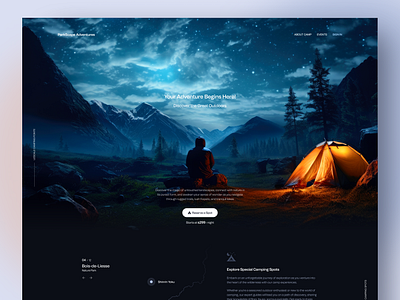Top Trends in Web Design That Will Shape the Future of Online Experiences
Top Trends in Web Design That Will Shape the Future of Online Experiences
Blog Article
Elevate Your Online Existence With Sensational Website Design Tips and Trends
The interaction of visual charm, present style trends, and customer experience plays a crucial role in attaining this goal. The subtleties of effective style prolong past looks; understanding essential strategies for optimization can dramatically influence your success.
Value of Visual Charm
This statistic highlights the crucial role that aesthetics play in user interaction and retention. Reliable visual design incorporates elements such as shade systems, typography, imagery, and design, all of which add to a appealing and natural individual experience.
In addition, an aesthetically appealing web site infuses a sense of reliability and professionalism. Customers are more probable to rely on a website that looks well-structured and polished, which can significantly influence conversion rates. Alternatively, a unpleasant or cluttered style can lead to high bounce prices, as users may view the website as untrustworthy or out-of-date.
Additionally, the aesthetic facets of a website can share brand identity and values (Web design). Constant usage of branding elements, such as logo designs and shade schemes, strengthens acknowledgment and promotes a much deeper connection with the audience. To conclude, prioritizing visual appeal is vital for producing engaging, reliable, and brand-aligned online experiences that resonate with customers
Existing Layout Patterns
Modern internet design is continuously advancing, and staying upgraded with current patterns is vital for developing impactful on the internet experiences. One popular fad is the surge of minimalism, identified by clean lines, sufficient white area, and a concentrate on essential components. This strategy not only improves use however also allows content to take spotlight.
In addition, dark setting user interfaces have obtained appeal, supplying users with a visually striking choice while decreasing eye strain. This pattern lines up well with customer preferences, supplying a modern-day aesthetic that is both useful and trendy.
An additional significant fad is the incorporation of vibrant typography. Designers are significantly using huge, expressive font styles to create aesthetic hierarchy and convey brand name messages effectively. Combined with vibrant color schemes, this fad adds dynamism to internet pages.

Necessary Style Aspects
Effective internet design rests on several important layout components that with each other produce a cohesive and appealing individual experience. The initial of these components is design, which determines how content is organized on the page. A well-structured design not only enhances readability yet likewise overviews users via the site perfectly.
Shade plays a crucial function in layout, influencing emotions and brand name understanding. A harmonious shade palette can stimulate specific feelings and establish an aesthetic power structure, thus drawing focus to crucial elements. Likewise, typography is important; the selection of typefaces need to align with the brand identity and make certain clarity across gadgets.
Imagery, consisting of graphics and images, includes aesthetic rate of interest and can connect messages promptly. Premium images relevant to the content improve the total aesthetic and involvement. Furthermore, whitespace is commonly overlooked but is essential for creating equilibrium. It aids prevent mess, enabling users to focus on the important aspects without distraction.
Lastly, uniformity throughout all layout components enhances brand identification and makes navigating user-friendly. By meticulously integrating these crucial internet design components, web developers can develop aesthetically attractive and functional sites that captivate site visitors and encourage communication.
Individual Experience Optimization
A smooth user experience is crucial for keeping site visitors and driving conversions on an internet site. Optimizing customer experience (UX) includes comprehending your audience and tailoring design components to fulfill their demands effectively. Trick parts of UX optimization include user-friendly navigation, fast packing times, and clear phone call to action.
Incorporate breadcrumb trails to help customers easily backtrack, minimizing disappointment. Rate is one more vital aspect; internet sites must pack within 3 secs to stop individuals from deserting the site.
Moreover, your internet site's design need to prioritize clearness. Usage understandable font styles, contrasting shades, and whitespace to create a visually attractive format that overviews customers with web content effortlessly. Phone calls to activity must be plainly presented, utilizing actionable language that encourages customers to involve.
Mobile Responsiveness Strategies
Nearly fifty percent of all internet traffic currently stems from mobile tools, underscoring the significance of executing robust mobile responsiveness strategies. To guarantee optimum user experience throughout various screen sizes, web designers should accept a liquid grid layout that adjusts effortlessly to various gadgets. This technique enables web content to resize and restructure without endangering functionality or visual appeals.
Incorporating flexible pictures and media inquiries is vital. Photos must immediately readjust their size according to the viewport, while media queries can webpage discover device attributes and apply tailored CSS designs as necessary. This strategy improves tons times and guarantees that individuals have an aesthetically enticing experience.
Additionally, focus on touch-friendly navigating aspects. Buttons and links need to be quickly tappable, with sufficient spacing to stop misclicks. Avoiding hover-dependent communications further boosts usability on touchscreens.
Lastly, conducting normal testing throughout various gadgets and browsers is vital. Tools like Google's Mobile-Friendly Examination can aid determine locations requiring enhancement. By adopting these mobile responsiveness techniques, businesses can improve user involvement, boost online search engine positions, and inevitably drive conversions, therefore elevating their on the internet existence efficiently.
Final Thought
By prioritizing aesthetic allure through existing style patterns and essential components, companies can foster credibility and interaction. Maximizing user experience and making certain mobile responsiveness are essential for promoting smooth interaction throughout devices.

On the other hand, a cluttered great site or unappealing layout can lead to high bounce rates, as individuals might regard the internet site as untrustworthy or out-of-date. - Web design
Reliable internet style hinges on a number of vital style components that together produce a cohesive and appealing user experience. Optimizing individual experience (UX) entails recognizing your target market and tailoring design components to satisfy their needs effectively.
Report this page